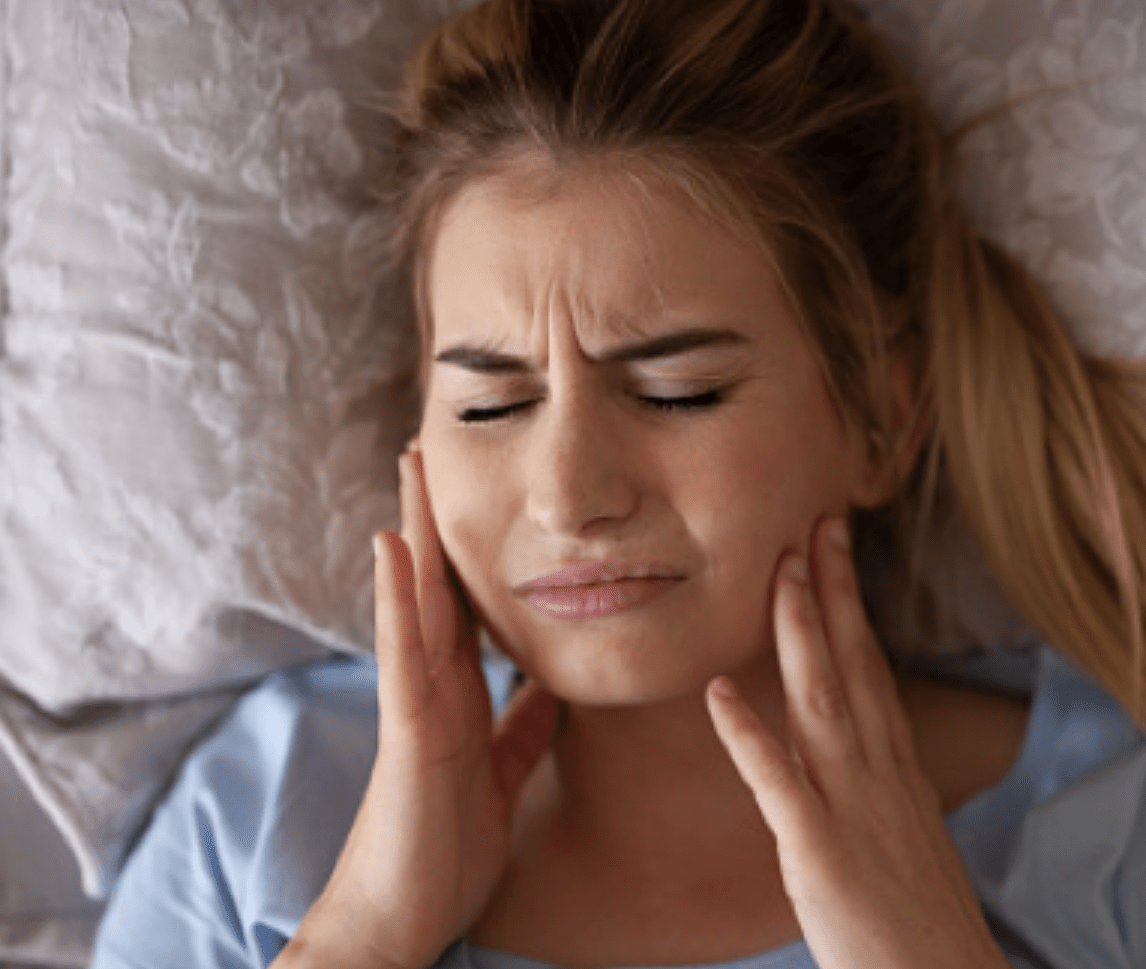- Exercise Tips for Hypermobility - 24 July 2024
- Creatine Benefits for Hypermobility and EDS - 21 July 2024
- Low-Dose Naltrexone For Fibromyalgia - 29 May 2024
Please click below if you would prefer to listen to this article on Temporomandibular Joint Dysfunction.
We have worked with clients for a long time, and many present with Temporomandibular Joint Dysfunction (TMJD). These clients all seem to have tried the same generic exercises to help alleviate their jaw pain. However, these generic exercises don’t seem to have much of a positive effect, mainly down to one issue: they don’t take muscle tone into issue or even focus on it. So, we wanted to use this article to run down some of the TMJD issues and show you some of the best exercises we recommend for the temporomandibular joint (TMJ).
This article covers:
ToggleWhat is Temporomandibular Joint Dysfunction?
TMJD is a condition that affects the mechanics of the TMJ. However, it may be more prevalent in individuals with conditions such as hypermobility, where the connective tissues are laxer than they should be.
Over time, TMJD can lead to several issues, including:
• Sleep disturbances: These can increase pain levels.
• Pain around the jaw, ear, and temple: Persistent discomfort in these areas.
• Clicking, popping, or grinding noises: Sounds when moving the jaw.
• Headaches around the temples: Frequent headaches in the temple region.
• Difficulty fully opening the mouth: Limited range of motion.
• Jaw locking: The jaw can lock when opening the mouth.
The temporomandibular (tem-puh-roe-man-DIB-u-lur) joint functions like a sliding hinge, connecting the jawbone to the skull. Each person has one TMJ on either side of the jaw. TMJ disorders, a type of temporomandibular disorder (TMD), can cause pain in the jaw joint and the muscles controlling jaw movement.
TMJ dysfunctions often affect the jaw joints and surrounding muscles and ligaments, leading to jaw pain, headaches, and difficulty opening and closing the mouth. While some people refer to these conditions as TMJ, the correct term for the disorder is TMD, which stands for temporomandibular joint dysfunction.
You have two TMJs located just in front of each ear. They connect the lower jawbone to the skull and facilitate movements like chewing and speaking. Between 5% and 12% of adults have some form of TMJ disorder, with the condition being twice as common in women and people assigned female at birth compared to men and those assigned male at birth. The most affected age group is between 20 and 40 years old.
Healthcare providers classify TMDs into three main categories:
1. Disorders of the jaw joints.
2. Disorders of the chewing muscles.
3. Headaches resulting from TMD.
Who is Affected?
Estimating how many people suffer from Temporomandibular Disorders (TMD) nationally is tricky due to data collection challenges. Still, it’s believed that anywhere from 10 to over 35 million people in the United States are affected at any given time.
More research is needed to understand the true prevalence of this condition.
Both men and women experience TMD, but women, particularly those in their childbearing years, tend to suffer the most severe symptoms. As the severity of symptoms increases, the ratio of women to men also rises, nearing nine women for every man dealing with major jaw movement limitations and chronic, relentless pain.
What does a TMJ flare-up feel like?
TMJ pain can manifest in a variety of ways, and the way it can feel can be varied. TMJ pain isn’t limited to just the jaw: it often presents with a range of other symptoms that can affect different parts of the head, neck, and face. Common symptoms associated with TMJ pain:
• Pain in Teeth: This can be a direct result of the misalignment of the jaw or grinding of teeth, often linked to TMJ dysfunction.
• Jaw Pain: This is the most obvious symptom, ranging from a dull ache to sharp, stabbing pain.
• Neck Tightness/Pain: The muscles around the jaw and neck are interconnected, so TMJ issues can often lead to neck discomfort or tightness.
• Heavy Headedness: This feeling of pressure or weight in the head can be associated with TMJ, often due to muscle strain and tension.
• Tightness/Pressure in Face: TMJ dysfunction can lead to a sensation of tightness or pressure in the face, particularly around the temples and cheeks.
• Tingling on the Side of the Face/Back of the Head: Nerve irritation from TMJ issues can cause tingling or numbness in these areas.
• Ringing in Ears: Tinnitus can be a symptom of TMJ as the jaw joint is located very close to the ear canal, and issues with the jaw can affect the ear.
It’s also important to note that TMJ pain can fluctuate due to various factors like stress, posture, or even how you sleep.
What causes TMJD?
Temporomandibular Joint Dysfunction is a multifaceted condition, and often, there can be multiple causes across the whole Biopshyocial spectrum, making it tricky to pinpoint a single origin for the disorder. For many, social factors like their job or even money worries can lead to stress and bruxism (clenching of the teeth); for others, as you will see, connective tissue disorders and tissue laxity can be a predisposing factor. However, the TMJ itself is a complex structure that combines both hinge and sliding motions to allow for smooth movements, thanks to the cartilage-covered bones and a shock-absorbing disk. Yet, when these elements are disrupted, TMJD can quickly appear.
Mechanical Causes
1. Disk Issues: The disk within the TMJ can erode or move out of alignment, leading to improper joint function and pain.
2. Cartilage Damage: Arthritis, including both rheumatoid arthritis and osteoarthritis, can damage the cartilage within the joint, contributing to TMJD.
3. Joint Injury: Trauma to the jaw, such as a blow or impact, can damage the TMJ and surrounding structures, leading to dysfunction.
Risk Factors
Various factors can increase the risk of developing TMJ disorders:
• Arthritis: Different types of arthritis, particularly rheumatoid arthritis and osteoarthritis, can affect the TMJ.
• Jaw Injury: Injuries to the jaw can disrupt the normal function of the TMJ.
• Bruxism: Long-term grinding or clenching of teeth (bruxism) can wear down the TMJ and surrounding muscles.
• Connective Tissue Diseases: Conditions like Ehlers-Danlos syndrome (EDS), which affect connective tissues, can lead to TMJ dysfunction due to joint hypermobility and instability .
Hypermobile Population and EDS
TMJ disorders are notably more prevalent among individuals with Ehlers-Danlos syndrome. EDS, a group of inherited disorders affecting connective tissues, leads to joint hypermobility, including in the temporomandibular joints. This hypermobility can cause the jaw to dislocate frequently and lead to chronic pain and dysfunction. Studies show that up to 71% of patients with EDS report TMJ-related pain, highlighting a significant overlap between these conditions.
Other Contributing Factors
• Malocclusion: When the teeth do not fit together correctly, it can place extra stress on the TMJ.
• Stress: High levels of stress can lead to increased muscle tension around the jaw, exacerbating TMJ issues.
• Habits: Using teeth as tools, poor posture, chewing on non-food items, and excessive gum chewing can all contribute to TMJ strain.
Complications of TMJD
If left untreated, TMJD can lead to a variety of complications, including:
• Chronic Pain: Persistent jaw, ear, and temple pain.
• Limited Chewing Function: Difficulty opening the mouth fully and performing everyday tasks like chewing.
• Bruxism-Related Wear: Damage to teeth from grinding and clenching.
• Sleep Disturbances: TMJD can disrupt sleep, which can worsen pain and affect overall health.
How is it diagnosed?
Diagnosing TMJ disorders can be very complex as there is no single standard test for these conditions. Historically, TMJ disorders were primarily linked to tooth alignment (malocclusion) and jaw mechanics. When all you have is a hammer, everything looks like a nail, I guess.
This essentially means that getting a diagnosis often involves applying pressure to various parts of the face to test for sensitivity and measuring how wide a person’s mouth can open. Additionally, imaging techniques like X-rays and CT scans examine jaw and disc positions and movements.
However, a significant shift in understanding TMJ disorders emerges from the National Institutes of Health’s OPPERA study (Orofacial Pain: Prospective Evaluation and Risk Assessment). This research highlighted the need to view TMJ disorders not just as localised issues but more so as complex and systemic conditions involving genetic, immunologic, and central nervous system factors that they are. The study revealed that TMJ disorders might involve changes in the brain and spinal cord, leading to a mismatch between the severity of pain experienced and the actual physical damage seen in the jaw joint, which is something that no other study had even considered.
The OPERA study did not produce specific diagnostic tests for TMJ disorders, but it did emphasise the importance of a comprehensive approach to diagnosis and treatment. This involves assessing the “whole person” and integrating various medical and allied health specialists. While not a new diagnostic tool right now, it at least pushes us in the right direction.
Additionally, the study found that TMJ disorders often coexist with other conditions, making it essential to consider a patient’s overall health. Common comorbid conditions include irritable bowel syndrome (IBS), genital pain, tension-type/migraine headaches, bruxism (teeth clenching or grinding), poor sleep quality, and chronic fatigue. The study also noted that factors like poor sleep quality and cigarette smoking could increase the risk of developing TMJ disorders. There is evidence suggesting that higher exposure to estrogen in utero might contribute to TMJ disorders, indicating hormonal influences.
When diagnosing TMJ disorders, healthcare professionals may employ several techniques, some of theese may include physical examinations to check for swelling, tenderness, and the range of motion in the jaw. Imaging tests such as X-rays, CT scans, and MRIs are often used to provide detailed views of the bones, joint tissues, and overall structure of the jaw to highlight any abnormalities.
However, It’s very important to rule out other conditions that might mimic TMJ symptoms, which can include sinus or ear infections, dental issues like decayed or abscessed teeth, various types of headaches, facial neuralgia, giant cell arteritis, coronary artery disease, connective tissue disorders (e.g., Ehlers-Danlos syndrome, scleroderma), tumours and cancers in the head, neck, or breast, Lyme disease, acromegaly, and true serum sickness.
What is the best exercise for TMJ?
One of the main areas you should focus on when exercising and improving the TMJD is increasing the tone of surrounding muscles, such as the lateral pterygoid. Doing so helps the muscle decompress the jaw, relieving pressure from the TMJ when resting. This is very important, as many people are unaware that your teeth should only be touching when you eat. At all other times, your teeth should never touch. So, If you are reading this and have suddenly realised that your teeth are indeed touching or most likely clenched, then the TMJD exercise video below is for you.
Working the lateral pterygoid muscle is the best exercise for addressing TMJ dysfunction. The lateral pterygoid is crucial for protracting and decompressing the jaw and maintaining proper jaw alignment, helping to alleviate the pressure on the temporomandibular joint. Additionally, targeting this muscle specifically can reduce the compactness and compression that often lead to pain and dysfunction. This exercise decompresses the joint and strengthens the muscle, providing long-term benefits and improving jaw mobility. Regularly engaging in lateral pterygoid exercises can significantly decrease the occurrence of headaches and jaw discomfort, leading to better sleep and overall quality of life.
Please let us know how you get on with the exercises. Good luck!
— Adam —
Have you checked out our hypermobility resource page?





